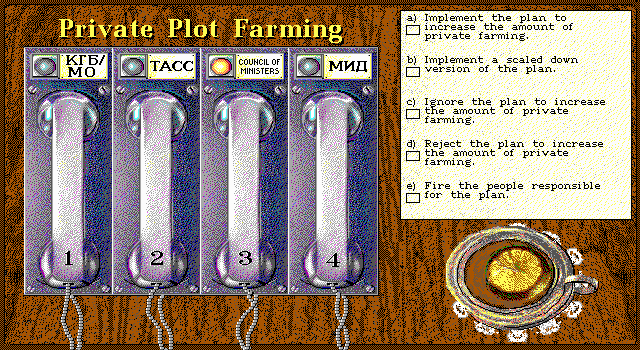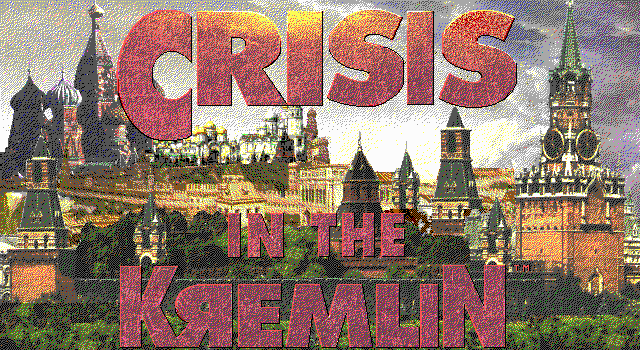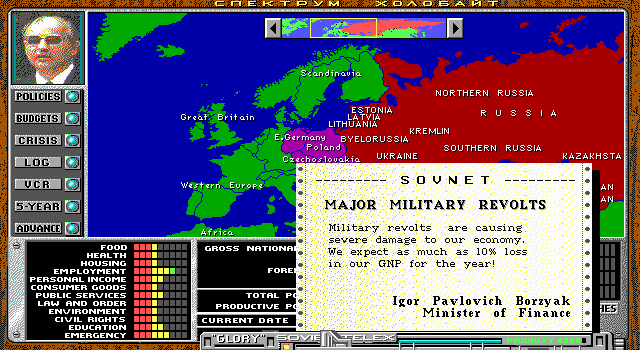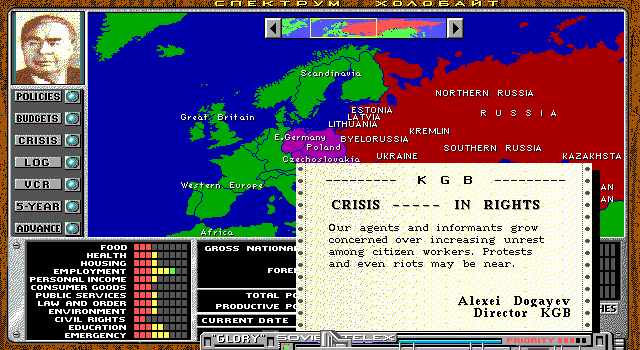Retro Replay Review
Gameplay
Crisis in the Kremlin delivers a deep political simulation that places you at the helm of the USSR during its most turbulent years. You choose to lead as Ligachov, Yeltsin, or Gorbachev, each with distinct strengths, weaknesses, and political capital. Decisions on foreign policy, domestic reform, and economic controls all rest on your shoulders, and even seemingly minor choices can trigger major ripple effects throughout the entire nation.
(HEY YOU!! We hope you enjoy! We try not to run ads. So basically, this is a very expensive hobby running this site. Please consider joining us for updates, forums, and more. Network w/ us to make some cash or friends while retro gaming, and you can win some free retro games for posting. Okay, carry on 👍)
Throughout each turn—representing a quarter of a year—you’re presented with crises ranging from the high-stakes Chernobyl disaster to sudden nationalist uprisings and demands for market reforms. Balancing the demands of hardline Nationalists against the momentum of Reformists forces you to prioritize and sometimes compromise. Misjudge public opinion or alienate key factions and you risk a vote of no confidence or outright revolt.
Replayability is a significant strength. Playing as Gorbachov invites a cautious, reform-minded approach, while Yeltsin’s path leans toward rapid liberalization and shock therapy. Ligachov challenges you to uphold traditional Communist doctrines in the face of mounting pressure for change. Each ruler’s unique starting conditions and political alliances ensure no two playthroughs feel identical, making Crisis in the Kremlin a compelling sandbox for strategy fans.
That said, the learning curve can be steep for newcomers to political sims. The interface packs numerous sliders, reports, and graphs that may overwhelm at first glance. However, once you grasp the flow of quarterly turns—setting budgets, approving or vetoing reforms, negotiating with foreign powers—the game’s strategic depth truly shines.
Graphics
Visually, Crisis in the Kremlin opts for functional clarity over flashy presentation. The game’s main screen displays a map of the USSR broken down by republics, colored to reflect political loyalty or unrest. While the art style and resolution feel dated by modern standards, they effectively communicate necessary information without unnecessary frills.
Menus are text-heavy and data-centric, with charts tracking economic output, approval ratings, and military readiness. Pop-up windows detail crises as they unfold—complete with concise summaries and multiple choice responses. Although there’s little in the way of cinematic cutscenes or animated sequences, the interface’s straightforward layout keeps your focus firmly on policy decisions.
Small touches—like the portraits of party officials and foreign leaders during diplomatic exchanges—add flavor to interactions. Ambient sound effects, from ticker-tape style news bulletins to murmurs in Politburo meetings, contribute to the atmosphere. These minimalist audio-visual elements work together to evoke the era’s tension without distracting from gameplay.
Given its 1991 release, graphical fidelity understandably lags behind contemporary titles. Yet for a political sim of this vintage, Crisis in the Kremlin holds up admirably. If you value substance over spectacle, the game’s UI and aesthetic serve the experience rather than overshadow it.
Story
Rather than a linear narrative, Crisis in the Kremlin unfolds as a reactive tapestry of historical and hypothetical events. You never know when a meltdown at Chernobyl will force you into crisis management, or when separatist agitation in the Baltics will test your resolve. This dynamic storytelling hinges on your policy choices, creating emergent scenarios that feel uniquely yours.
Playing as Gorbachev, you’ll witness the agony of glasnost and perestroika firsthand, with opportunities to liberalize the press, restructure collective farms, or invite foreign investment. As Yeltsin, expect radical pushes towards privatization and market economics, though beware the social upheaval and inflationary spikes that often accompany rapid change. Selecting Ligachov transforms your tenure into a conservative struggle to uphold Soviet orthodoxy.
Each crisis event reads like a bite-sized historical vignette, often accompanied by a brief news-style report that frames the stakes. Will you send in troops to quell demonstrations, or negotiate reforms to placate protesters? These dilemmas force you to weigh ideology against pragmatism, and often reveal uncomfortable truths about power.
Although there’s no traditional “ending” with cutscenes or credits, the real narrative emerges in the final simulation results: economic health, public approval, military strength, and the survival of the union itself. Can you maintain stability longer than the historical USSR, or will your own mistakes hasten the state’s collapse? That uncertainty keeps the story alive across multiple campaigns.
Overall Experience
Crisis in the Kremlin stands out as one of the few political simulations that truly immerses you in the challenges of governing a superpower in decline. Its combination of turn-based mechanics, factional balancing, and unpredictable crises delivers a uniquely cerebral experience. It’s a game best enjoyed by those who relish strategic depth and historical context.
While its dated presentation and text-heavy interface may deter casual players, fans of government sims and Cold War history will find plenty to appreciate. The satisfaction of navigating a Chernobyl-level catastrophe, brokering peace with Eastern Bloc allies, or steering economic reform without triggering hyperinflation is unmatched in other strategy titles.
Multiplayer isn’t an option here, but the solo challenge remains robust: experimenting with different leaders, adjusting policy sliders, and aiming to outperform historical outcomes. Every decision feels weighty, reinforcing the notion that governing is as much about compromise as it is about conviction.
For potential buyers seeking depth, replayability, and a window into late-Cold War politics, Crisis in the Kremlin offers an engrossing—and often humbling—simulation. Can you do better than Gorbachev himself? Only one way to find out.
 Retro Replay Retro Replay gaming reviews, news, emulation, geek stuff and more!
Retro Replay Retro Replay gaming reviews, news, emulation, geek stuff and more!









Reviews
There are no reviews yet.